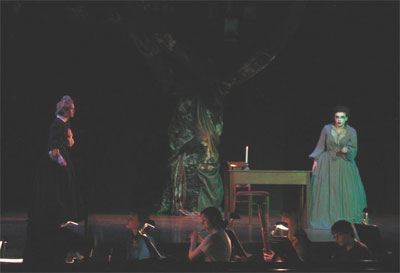by Alison Kozol
Alison Kozol participated in the Oberlin Winter Term class in Digital Musical Journalism co-sponsored by ClevelandClassical.com and team-taught by CC correspondent and Oberlin English professor Nicholas Jones and CC staffers Mike Telin and Daniel Hathaway. Here, Ms. Kozol writes about the Thursday, February 3 opening performance of one of the two Winter Term operas, Benjamin Britten’s The Turn of the Screw.

Such an eerie atmosphere is necessary for an opera like The Turn of the Screw, Benjamin Britten’s adaptation of Henry James’ novella of the same name. The story follows the unnamed Governess throughout her experience with the Bly mansion, a sprawling home teeming with ghosts, and Sara Casey, a fifth-year at Oberlin, did the character justice. Her transition from cheerful to weary to terrified set the tone for the entire performance, and her voice was flawless as it mimicked her tumultuous mood. Perhaps the most spell-binding moments, however, were when she was most flabbergasted by the supernatural around her and instead of singing, whimpered her disbelief.
Probably the most notable performance of the night was Elizabeth Perry’s take on Ms. Grose, the secretive and worried housekeeper. Perry’s vocal performance was incredible, and although her character doesn’t have the romantic innocence of the two Bly children or the mystique of the elusive Miss Jessell and Mr. Quint, she sang every note with conviction — or uncertainty, depending on the context. Perry’s performance is reflective of the best parts of the production; her stripped-down technique invoked more emotion than some of the more heavy-handed acting and singing. Although there were a few over-indulgent scenes where actors seemed too dramatic, most of the opera was believable and enjoyable.
This is all overlooking the magnificent orchestra, directed by Alan Montgoomery. Britten’s piece is broken into sixteen segments which serve as the perfect wrap-up, foreshadowing and filler between scenes, and as a whole, highlights each instrument at different points. Bethany Wheeler’s beautiful and unnerving harp performance was particularly spellbinding; so was Derek Zinsky’s strenuous feat, as he switched between the piano and celeste, adding creepy resonance to every piece.
The Turn of the Screw was certainly an accomplishment, for the cast managed to put together a cohesive, intelligible performance in a short month. Perhaps the lack of ornamentation was because of the lack of production time, but the stripped-down set worked to the actors’ advantage.



